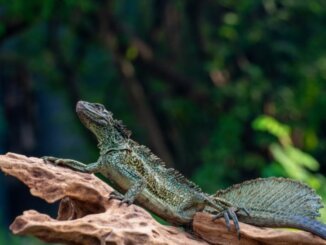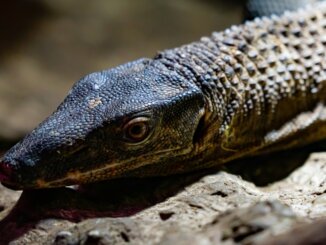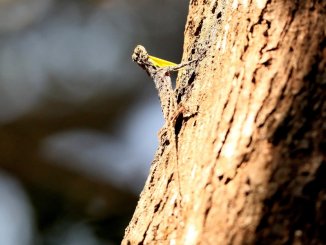The green basilisk is a triangular-headed lizard with a laterally compressed body covered in tiny green scales. This lizard has gray, white, or light blue markings across its body that give it a unique appearance. The green basilisk is originally from Central America in the tropical rainforests of Costa Rica, Nicaragua, Honduras, and Panama.
Keeping green basilisks is difficult, but their beautiful colors and exciting behavior make them a popular choice among reptile enthusiasts. Green basilisk lizards require large enclosures, controlled temperature, hydration, and constant attention to their diet.
Green Basilisk Overview
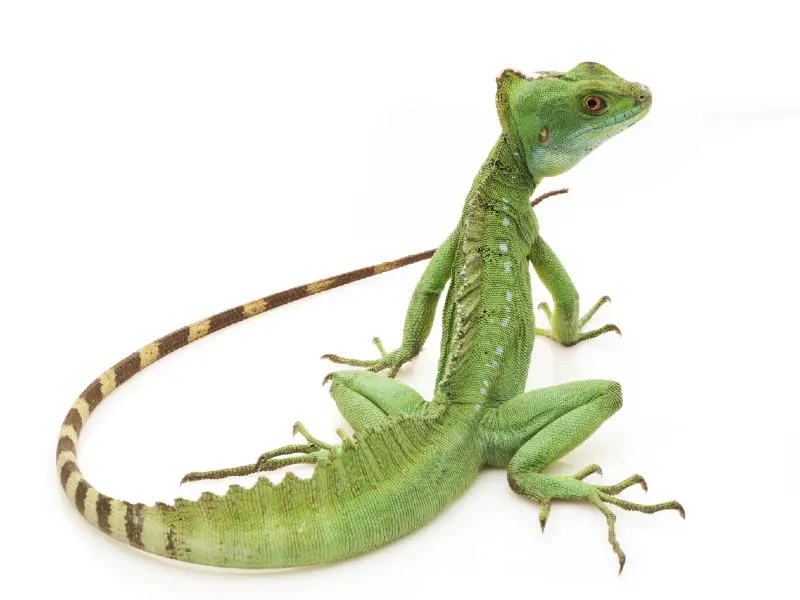
| Common name (s) | Green basilisk, double crested basilisk, plumed basilisk |
| Scientific name | Basiliscus plumifron |
| Natural habitat | Tropical rainforests in Central America |
| Adult size | Two feet long (including the tail) |
| Average lifespan | 5–6 years (in the wild), 10 years (in captivity) |
| Diet | Omnivore |
| Housing | Vivarium |
| Experience level | Expert |
Origin
The green basilisk (Basiliscus plumifrons) is endemic to Central America, in the tropical rainforests of Costa Rica, Nicaragua, Honduras, and Panama. The lizard is semi-arboreal and semi-aquatic, meaning that it is agile both on the ground and in the water. The green basilisk thrives at a sea-level elevation ranging from 2,542 ft.
Green basilisk lizards are common in their natural environment. This lizard is an exotic species better known for its ability to walk and run on water with its two hind legs. The green basilisk is popular among reptile enthusiasts because of its beautiful colors and high activity level.
Appearance and Behavior
Green basilisks are slender-bodied lizards with laterally compressed bodies and triangular-shaped heads. The lizards have long whip-like tails and long toes that unfurl when running on water. Green basilisks have crests that run lengthwise from their heads to their tails.
Green basilisks are bright green with white, light blue, or gray spots across their bodies. Some green basilisks have thin black bands around their tails, while some don’t have any markings. The eyes of these lizards have a yellow iris with round pupils.
Male green basilisks are bigger than the females. The males have distinctive double high crests on their heads to impress the females when mating. Female green basilisks have a single smaller crest on their heads and tails.
Size and Lifespan
Green basilisks are, on average, two feet long, including the tail. The tail of a green basilisk is 25 inches long, which accounts for more than 50% of the lizard’s total length. Green basilisks weigh about seven ounces.
Green basilisks have an average lifespan of 5–6 years in the wild and ten years in captivity. The lifespan of a green basilisk in the wild is shorter because they have no protection against predators, such as birds and snakes. Providing these lizards with the proper living conditions, diet, and habitat keeps them healthy in captivity.
Temperament
Green basilisks get upset easily. They are aggressive when they feel threatened and demonstrate this by puffing out their necks and snarling. Green basilisk lizards can also bite, but they aren’t poisonous.
Green basilisks will shimmy over sand, hop, or run when they sense danger. They’re territorial creatures and spend most of their time on trees and rocks close to water bodies. Male green basilisks are especially territorial and will defend their territory against other males.
Keeping more than two males in a single enclosure can lead to fighting. Female green basilisks can live together, but it is best to have only one female in an enclosure. Single male and female green basilisks can stay together only when they’re mating.
Green basilisks are difficult to handle. They are shy, nervous, and usually temperamental. Handling them carelessly can lead to stress.
Housing Green Basilisks
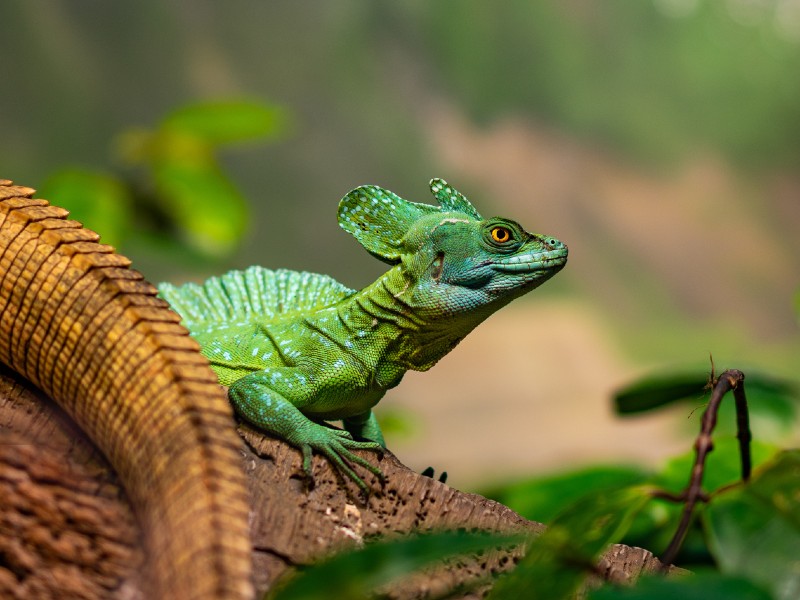
Mimicking the natural habitat of green basilisks ensures a healthy and happy life for the lizards. The wild habitat of the green basilisk has dense vegetation, leafy branches for resting and climbing, rocks to bask on, and a close-by water body.
The ideal enclosure for green basilisks is a wooden vivarium. The wood ensures consistent humidity and temperatures, which are critical for this species. The taller the vivarium, the better, because green basilisks like to climb and bask on branches.
Green basilisks live in tropical rainforests and are semi-aquatic and semi-arboreal. A vivarium with an arboreal and aquatic section is ideal.
Enclosure Size
A green basilisk’s vivarium should measure six feet long, two feet wide, and four feet high. These lizards are large and need room to move around. Hatchling green basilisks can survive in a 50-gallon breeder tank but will require larger quarters as they grow.
Lighting
UVB lighting is an excellent addition to your green basilisk enclosure. A T8 or T5 UV tube mounted on the enclosure ceiling about 12 inches from the basking area is ideal. The green basilisk is a diurnal species, so UV lighting helps its bone and muscle development and regulates its day and night cycle.
You should turn off all the lights at night to ensure your green basilisk has a clear day and night cycle. Replace the UV tubes after six months for the T8 lamps and 12 months for the T5 lamps to ensure the lamps emit light evenly.
Temperature and Humidity
Green basilisks are tropical lizards. Providing proper temperature and humidity is vital for their health.
Different parts of your green basilisk’s enclosure will require different temperature levels. The ambient temperature should range between 90 and 95 degrees, with a basking spot at 95 degrees Fahrenheit during the day and 75-80 degrees Fahrenheit during the night.
Provide a heat source that covers at least 1/3 of the enclosure while targeting the basking spot. A basking lamp attached to a dimming thermostat on one end of the enclosure will provide an excellent basking spot.
The humidity inside the vivarium should be about 60%–70% throughout the year. Misting the enclosure twice daily using an automatic misting system is best to keep the humidity levels constant. Use a hygrometer to ensure the humidity levels are within the required range and a thermostat to monitor the temperature levels.
Skin shedding in the green basilisk is a natural process. The lizard sheds its skin in flakes or patches at regular intervals. If you don’t maintain humidity and temperature levels, your lizard may experience skin drying and abnormal shedding.
Substrate and Decoration
The best substrate for your green basilisk enclosure is eco-earth. Plantation soil and jungle mix are also suitable. Other substrates, such as coconut coir and dry leaves, provide a soft surface and help maintain humidity levels.
The substrate should be four inches deep to allow enough room for burrowing. Ensure the substrate is durable enough to withstand the strong claws of your green basilisk. Add in a few pieces of rocks, branches, and plants for climbing.
The green basilisk is a semi-arboreal lizard, so your vivarium must have many perches at different levels. The lizard is also semi-aquatic and likes to swim in its natural habitat. A water bowl that is deep enough for your green basilisk to submerge is an ideal addition to the enclosure.
The green basilisk spends most of its time basking. A large rock placed near the basking lamp will provide a warm environment for the lizard.
Cleaning
You should spot clean the vivarium every day and do a full clean at least once every four weeks to ensure maximum hygiene. Wipe out the enclosure with a wet cloth and regularly disinfect with a weak bleach solution. Thoroughly rinse out the enclosure to ensure there are no traces of bleach before returning your green basilisk.
Remove feces and uneaten food every day to maintain a clean enclosure. Avoid using scented cleaners and disinfectants, as these can irritate the respiratory system of the green basilisk.
Green Basilisk Care
Taking care of the green basilisk is quite tricky. New hobbyists often find it challenging to maintain the high humidity and temperature levels required for the lizard. Experts and professionals with previous experience handling the green basilisk are best suited to keep the species.
Providing an environment that mimics the natural habitat of green basilisk lizards is the most critical part of their care. You should maintain the proper temperatures and consistent humidity levels. You should also provide perching surfaces, basking spots, and a suitable substrate.
Food and Water
Green basilisks are omnivorous. The lizards feed on insects and vegetables in the wild. Providing your green basilisk with fresh vegetables, insects, and small invertebrates will ensure healthy growth. Feed your lizard crickets, earthworms, silkworms, termites, fly larvae, and other feeder insects at ten-minute intervals. Vegetables such as collard greens, spring mix, and kale help balance the diet.
Hatchling green basilisks are insectivorous, meaning they prefer to eat small insects. Provide your hatchling with small crickets, fruit flies, and pinhead crickets. Introduce vegetables to juveniles and adults gradually to avoid indigestion and bloating.
You should feed hatchling green basilisks three times per day, juveniles once each day, and adults thrice-weekly. Give your green basilisk access to clean water free of chlorine and bleach. Avoid feeding green basilisks food larger than the size of their heads. Oversized foods can cause the lizards to choke and die.
Handling
Green basilisks don’t appreciate handling. They like being left alone and will show aggression if you try to handle them. However, some green basilisks can tolerate human interaction and will calm down once they get used to the experience. Handling green basilisks regularly can help them develop trust towards humans and ease their aggression.
To correctly handle a green basilisk, scoop the lizard from below while supporting its body weight as much as possible. Avoid grabbing the lizard from above as this can cause stress or aggressive behavior. Start with short periods of handling and build up with time.
Nearby predators such as birds, snakes, and other reptiles can cause stress to green basilisks. Territorial fights between males can also cause stress. If your green basilisk is stressed, it may bang its nose on the enclosure’s sides, bob its head, and hide in the corners of the enclosure.
Common Health Issues
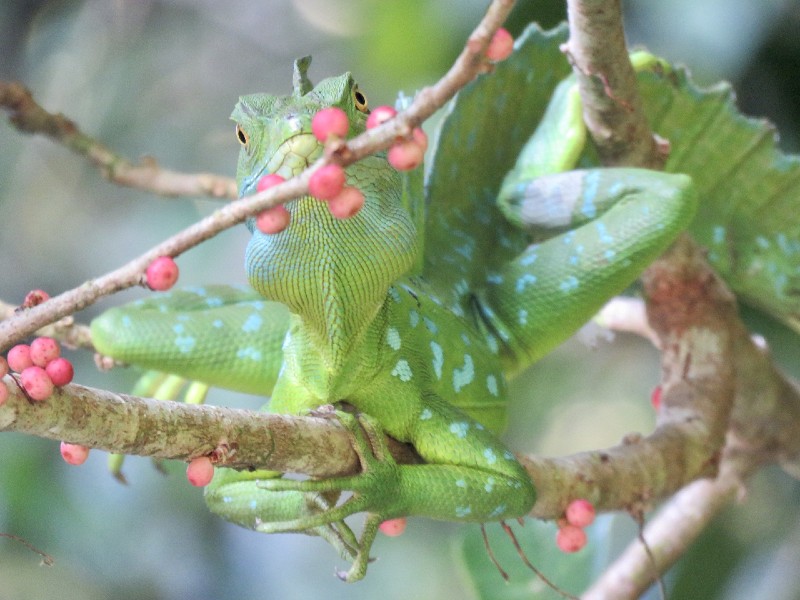
Green basilisks are subject to attack by parasites and diseases. Some of the common health issues faced by a green basilisk include vitamin A deficiency, metabolic bone disease, and rostral injuries.
Vitamin A deficiency is a problem especially in hatchlings and young juveniles. Symptoms include a loss of appetite and yellowish discoloration of the mucous membranes. Lack of vitamin A affects the immune system and the eyesight of green basilisks, making them vulnerable to other infections.
Treating vitamin A deficiency involves feeding the lizard a diet high in carotenoids, including carrots and dark leafy greens. Vitamin A also helps the green basilisk fight off parasitic infections.
Metabolic bone disease (MBD) is a condition that results from a lack of calcium and vitamin D3. Signs of this disease include a loss of appetite, lethargy, fractures, and seizures. Severe cases of MBD require oral administration of calcium glubionate or injecting with calcium gluconate.
Rostral injuries are caused by nose banging and territorial fights. Symptoms include swelling and bruising around the face and nose area. A vet must prescribe antibiotic and anti-inflammatory medications to treat rostral injuries. Avoiding stressful situations and maintaining proper enclosure conditions can help prevent these injuries.
Breeding
Breeding green basilisks is an easy process. Most of the time, it only requires introducing the male and female in the same vivarium, and the two will mate.
Green basilisks don’t have particular temperature or light requirements to induce breeding. Standard parameters ideal for the lizard’s survival is enough for breeding. Seasonal changes may affect breeding in the wild, but nourished green basilisks can breed year-round.
You will need to prepare a breeding vivarium for successful breeding. A 50-gallon tank is adequate for breeding pairs. Provide moist soil at least 12 inches deep for the female to dig nesting holes. The soil temperatures should be around 85F to encourage the female to dig and lay her eggs.
Introduce the female first, then the male after a day or two. A reproductive female green basilisk should feed on minnows regularly. Dust the meals with calcium supplements and vitamin D3 supplements.
The male will respond to the pheromones released by the female and proceed to copulate. The female may show little resistance, or may not show any signs of aggression at all. Copulation takes several minutes to an hour.
A female green basilisk with eggs appears full and bloated. After about two months, she will start burrowing in the substrate to lay her eggs. The female will lay an average of 10 eggs in 3–5 minutes and cover them with the substrate.
Incubate the eggs in a temperature of 84–88 degrees Fahrenheit with constant humidity. The eggs will hatch after 60–70 days. Hatchlings will begin feeding within seven days. Feed the hatchlings tiny waxworms and mealworms with fruit flies in between.
Make sure to maintain the required vivarium parameters for your juveniles to reduce their risk of mortality. After a year and a half, green basilisks are usually sexually mature.
Choosing and Buying a Green Basilisk
Green basilisks cost $30–$100 depending on the age, size, and breeder. These lizards are readily available in pet stores, reptile expos, and online reptile shops. They’re also sold by professional breeders. No legal restrictions apply to the exportation and importation of green basilisks in the United States.
Check the green basilisks’ body condition, eyesight, skin health, and signs of illness before purchasing. Healthy green basilisks are bright green and alert, and their tails are fully extended.

